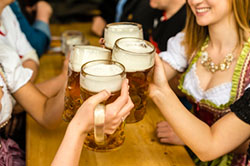Alcohol & Digestive Cancers: Time for Change
The European region has the highest levels of alcohol consumption in the world, with one fifth of the population aged 15 and above drinking heavily at least once a week. As a result, the continent also has the highest proportion of total ill health and premature death directly linked to alcohol. Alcohol consumption is a known risk factor for digestive cancers, including oesophageal, liver, pancreatic, colorectal and gastric cancer.

Alcohol and Digestive Cancers: Time for Change [1] highlights the alarming scale of alcohol consumption across Europe and its direct and indirect impact on digestive cancers. The report canvasses the opinions of leading European digestive cancer specialists, stakeholder organisations and patient groups, as well as endorsement from the Estonian Presidency of the Council of the EU.
Within the report, UEG classify ‘light’, ‘moderate’ and ‘heavy’ alcohol consumption:
- Light drinking: up to or 1 drink per day
- Moderate drinking: more than 1 and up to 4 drinks per day
- Heavy drinking: 4 or more drinks per day
The report stated that light drinkers have an increased risk of oesophageal cancer, moderate drinkers have an increased risk of colorectal cancer and heavy drinkers are at an increased risk of pancreatic, gastric and liver cancer. Combined, these five digestive cancers contribute to a third of all cancer deaths worldwide (almost three million deaths per year).
Citizens across the EU are drinking an average of 2 alcoholic drinks per day, with the highest consumption levels throughout eastern Europe (Lithuania, Czech Republic, Romania, Bulgaria and Croatia have the highest levels, respectively). The lowest levels of consumption were found to be in Malta, Italy, Greece, the Netherlands and Sweden.
However, all 28 EU Member States were found to have, on average, ‘moderate’ consumption levels, placing them at an increased risk of both oesophageal and colorectal cancer.
Other key points that were highlighted within the report included:
- Up to 90% of people are unaware of the link between alcohol and cancer
- Alcohol abuse accounts for up to half of all liver cancer cases in Europe
- There is a 52% increased risk of colorectal cancer when drinking more than four drinks per day
- Heavy drinkers are twice as likely to develop gastric cancer than light drinkers
- Oesophageal cancer contributes to 27% of alcohol-attributable cancer deaths in men
- Five or more drinks per drinking episode results in a 3.5 increased risk of pancreatic cancer
Read the full report (![]() 1.1 MB)
1.1 MB)
| EU Member State | Total alcohol per capita (≥15 years of age) consumption (litres of pure alcohol), projected estimates, 2016 | Alcohol consumption per capita (average daily intake in grams)1 | Average number of drinks per day2 |
| Lithuania | 18.2 | 39.5 | 3.2 |
| Czech Republic | 13.7 | 29.8 | 2.4 |
| Romania | 13.7 | 29.8 | 2.4 |
| Bulgaria | 13.6 | 29.5 | 2.4 |
| Croatia | 13.6 | 29.5 | 2.4 |
| Belgium | 13.2 | 28.7 | 2.3 |
| Estonia | 12.8 | 27.8 | 2.2 |
| United Kingdom | 12.3 | 26.7 | 2.1 |
| Latvia | 12.3 | 26.7 | 2.1 |
| Poland | 12.3 | 26.7 | 2.1 |
| Slovakia | 12.3 | 26.7 | 2.1 |
| Hungary | 12.3 | 26.7 | 2.1 |
| France | 11.7 | 25.4 | 2.0 |
| Germany | 11.4 | 24.8 | 2.0 |
| Slovenia | 11.3 | 24.6 | 2.0 |
| EU Average | 11.2 | 23.9 | 1.9 |
| Luxembourg | 11.1 | 24.1 | 1.9 |
| Finland | 10.9 | 23.7 | 1.9 |
| Ireland | 10.9 | 23.7 | 1.9 |
| Austria | 10.6 | 23.0 | 1.8 |
| Portugal | 10.6 | 23.0 | 1.8 |
| Denmark | 10.1 | 21.9 | 1.8 |
| Cyprus | 9.3 | 20.2 | 1.6 |
| Spain | 9.2 | 20.0 | 1.6 |
| Sweden | 8.8 | 19.1 | 1.5 |
| Netherlands | 8.7 | 18.9 | 1.5 |
| Greece | 8.5 | 18.5 | 1.5 |
| Italy | 7.6 | 16.5 | 1.3 |
| Malta | 7.5 | 16.3 | 1.3 |
Notes
- Given the specific weight of alcohol of 0.793 g/cm3 as defined by the World Health Organisation (at 20 °C), per capita consumption in litres of pure ethanol per year can be converted into grams per day as follows: g/day = APC x 1000 x 0.793/365 days
- Based on the assumption that the average alcoholic drink contains 12.5 g of alcohol
Reference
- UEG. Alcohol and Digestive Cancers Across Europe: Time for Change (
 1.1 MB). Published online July 4, 2017
1.1 MB). Published online July 4, 2017
Keywords: alcohol, oesophageal cancer, liver cancer, pancreatic cancer, colorectal cancer, gastric cancer
4. 7. 2017 UEG Press Release



